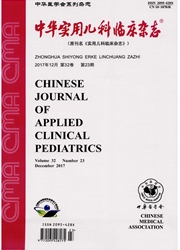

 中文摘要:
中文摘要:
目的探索小分子干扰RNA(SiRNA)沉默A549细胞肺表面活性蛋白A(SP-A)基因后高体积分数氧(高氧)对其的影响,探讨SP-A蛋白在高氧肺损伤中的作用。方法体外传代培养A549细胞,将细胞随机分为沉默组、对照组。以Lipofectamine2000转染特异性SiRNASP-A转入A549细胞,持续置于高氧(950mlVLO2和50mL/LCO2)中,分别于培养48h、72h、96h提取A549细胞的总蛋白,收集培养上清。采用Western-blot检测SP-A蛋白的表达,噻唑兰(MTF)检测细胞增殖能力,硫代巴比妥酸(TAB)比色法检测培养基上清中丙二醛(MDA)水平。结果序列特异性SiRNA可显著沉默SP-A基因表达,其中SiRNASP-A2的沉默效率最高(97%)。高氧干预下,与对照组相比,沉默组A549细胞SP-A蛋白表达在高氧48h、72h时均显著减少(P均〈0.05),沉默组A549细胞增殖能力在高氧48h、72h、96h均受到明显抑制(P均〈0.05)。但2组问培养基中MDA水平未见明显差异(P〉0.05)。结论SP-A基因沉默后A549细胞抗高氧能力下降,表明SP-A可能在高氧肺损伤过程起保护作用。
 英文摘要:
英文摘要:
Objective To explore the effect of hyperoxia on A549 cells suppressed with surfactant protein A (SP-A) suppressed by small interference RNA(SiRNA)-mediated gene silencing, and discuss the function of SP-A in hyperoxic lung injm'y. Methods A549 cells were gained by serial sub cultivation in vitro and randomly divided into 2 groups, silenced of SP-A group and the control group. A549 cells were transfected with synthetic SP-A sequence-specific SiRNA by Lipofectamine 2000, continuously exposed to hyperoxia(950 mL/L 02 ,50 mL/L CO2 ). After exposure to hy- peroxia for 48 hours ,72 hours and 96 hours ,total protein and culture supernatant were gained. SP-A protein was detec- ted by Western-blot, the capacity of proliferation was detected by methyl thiazolyl tetrazolium, and thiobarbituric acid colorimetric method was used to detect the malondialdehyde(MDA) in culture supernatant. Results Sequence-specific SiRNA targeted SP-A2 and significantly down-regulated its expression in A549 cells. Compared with the control group in hyperoxia, the expression of SP-A significantly decreased after 48 hours ,72 hours in the silenced group( all P 〈 0.05 ) , and the capacity of proliferation in A549 cells silenced by SP-A were obviously decreased after 48 hours ,72 hours and 96 hours ( all P 〈 0.05 ). But there was no significant difference in the MDA in culture supernatant between 2 groups ( all P 〉 0. 05 ). Conclusions The capacity of resisting hyperoxia decreased in A549 cells silenced by SP-A, which indi- cates that SP-A can protect hyperoxic lung injury.
 同期刊论文项目
同期刊论文项目
 同项目期刊论文
同项目期刊论文
 Synergetic Effect of alpha-Lipoic acid with Keratinocyter Growth Factor on Protection Alveolar Epith
Synergetic Effect of alpha-Lipoic acid with Keratinocyter Growth Factor on Protection Alveolar Epith 期刊信息
期刊信息
